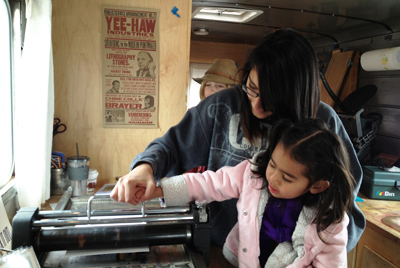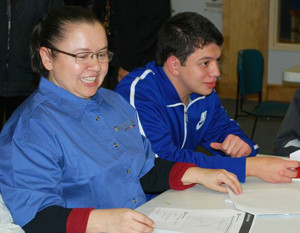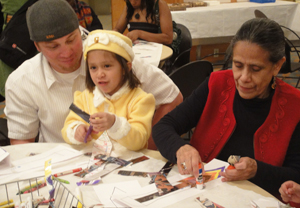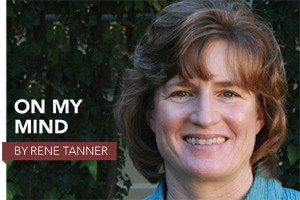
Gloria Velez waited 13 years to immigrate to America from war-torn Colombia, where one-third of all residents live below the poverty line. In the time it took to process her visa, much had changed. Her son had grown up and she had turned 47—too old now to be eligible for a job, she thought. Learning that Americans work into their 60s was just one of the cultural shocks Velez encountered when she and her son finally arrived in Illinois in the summer of 2013. That was nothing, she said, compared with her surprise at discovering that in this country, some programs and services are free.
Velez moved in with her brother, a US citizen, and at his suggestion enrolled in a free Spanish GED program offered at the Waukegan (Ill.) Public Library (WPL). She earned her degree in just a few months. Now Velez and her son serve as volunteer library promotores, helping other Latinos to take advantage of free library programs geared toward the unique needs of their expanding community.
Immigrants have continued to flow into the United States in rising numbers over the past decade, reaching a current population of more than 40 million, according to the latest data analysis by the Pew Hispanic Center. Of that total, the number of undocumented immigrants has stabilized in the past few years at just over 11 million. Nearly 40% of all foreign-born residents in the United States come from Mexico, Central America, and Cuba.
In response to the influx, libraries across the country are developing new strategies like WPL’s Promotores program to address the struggles of a growing Latino population. They’ve discovered the library’s traditional modus operandi—everything from distributing fliers to developing typical programs—doesn’t necessarily work with this demographic.
No clear-cut profile
One of the challenges libraries face is understanding that the Latino community is extremely diverse, says Yolanda J. Cuesta, a Sacramento, California–based consultant who specializes in helping libraries connect with diverse communities, particularly Latinos. “People come from many different areas, and educational and economic backgrounds,” she says. Some speak fluent English; some know just a little or none at all. Others speak neither English nor Spanish but rather an indigenous language, such as one of the many Mayan languages.
Juan Tornoe, a consultant for a marketing agency in Austin, Texas, says indigenous immigrants from his native country of Guatemala might speak any of 21 different dialects, not counting Spanish. He urges clients to be sensitive about how they approach the different segments of the community to establish relationships with all Latinos, not just Spanish speakers.

“You have to respect the culture,” Tornoe says. “In multigenerational Latino markets, they speak English, but they are still very Latino in their culture. They can get offended if you imply they don’t know the language.”
Age is a primary factor governing English-language proficiency among Latinos living in America. In a Pew study of US residents born in Mexico who speak a language other than English at home, only 23% of adults say they speak English “very well” compared with 65% of children between ages 5–18.
Adding to the market complexity, some Latinos enter the United States with college degrees while many never had the opportunity for a formal education.
Jose Tapia grew up one of seven children in rural Mexico. When he turned 8 years old, he got his first job on a neighbor’s farm, helping clean out pigsties. Tapia kept working to support his family while his younger siblings went to school, and, by age 15, had finally saved enough to pay a human trafficker to help him cross into the United States.
Now 34 years old and living in Illinois with his wife and children, Tapia recently began learning how to read and write in Spanish by taking Leamos, a free literacy class offered at WPL. He speaks with the help of a Spanish interpreter.
“When I first came to the Leamos class, I was nervous,” Tapia says, “but I saw the other students were far worse off than I was. At least I knew the alphabet.”
Nearly two out of every five US residents born in Mexico and Central America have less than a 9th-grade education, according to the Pew Hispanic Center.
“The reality is, even for Latinos who come here with degrees, it’s very difficult to transfer your educational background to find work in this country,” says Carmen Patlan, community engagement and Spanish literacy services manager at WPL. “Most people have to start from scratch, even highly trained engineers.”
Insular communities
Despite their heterogeneous backgrounds, people in Latino communities share some common characteristics. For instance, says Tornoe, they tend to be insular, relying on others who speak their language and share their immigrant experience as their primary sources of information.
“These folks are transplanted from a completely different environment,” he says. “They feel disenfranchised. They don’t know whether to trust what they hear. They may see a library flier and think ‘Who are you?’ But if someone they know and trust talks to them, that’s different.”
Language and literacy struggles can also contribute toward a preference for word-of-mouth over written communication.
“With all the resources available in Orlando, I was surprised to learn that [Latino immigrants] were just not using the public library,” says Howard Rodriguez-Mori, assistant professor in the School of Library and Information Studies at Florida State University. After studying the behavior patterns of Puerto Rican migrants in Central Florida, Rodriguez-Mori found they obtain immigration-related information from other Latinos at public venues, such as churches or supermarkets, and asking for advice.
For undocumented immigrants, the reluctance to seek help from institutions and strangers often stems from a fear of government agencies and deportation, says WPL’s Patlan, who remembers her own experience emigrating from Mexico. “Immigrants may not access the resources available to them because they don’t want to expose themselves,” she says. “If one neighbor gets detained, word flies through the entire community.”
Some Latinos have misconceptions about what a library is, according to Patlan. The word “library” resembles librería, the Spanish word for bookstore. Many Latinos don’t visit because they think they can’t afford it; or if they do visit, they’ll ask how much the books cost, she says.
And those familiar with libraries from their native countries oftentimes don’t understand the scope of resources and services available at American libraries.
Rodriguez-Mori says his experience with libraries in Puerto Rico was not at all like what we know in the States. “The library was just an archive of old, outdated books in a small room, open during very limited hours,” he says.
Networking
The most effective way to reach out to Latino populations, says Cuesta, is to build relationships with community leaders. She says such leaders already have the trust of many Latinos. From her experience, churches typically offer the “first inroads” to Spanish-speaking communities. She also recommends looking for names of prominent community members in bilingual newspapers and talking with social service agencies, community service groups, and chambers of commerce.
Around 2000, when Jackson, Wyoming, saw a wave of immigrants arrive from Tlaxcala, Mexico, staff members at the Teton County (Wyo.) Library turned to networking. The library cofounded the Latino Services Network, a group of 25 organizations—including health service agencies, schools, park districts, and safety and counseling centers—to meet monthly to help ensure new immigrants transitioned smoothly into the community.
Assistant Director Isabel Zumel says the group serves as ambassadors for one another, helping cross-promote what each organization has to offer. “If someone from Head Start tells a family to go to the library, they’ll go to the library because there’s already a trust there,” she says.
Similarly, at the Denver Public Library (DPL), drop-in Community Learning Plazas serve as a portal to immigration services offered by multiple agencies throughout the metropolitan area. These plazas provide programming created in partnership with family resource centers and small businesses, as well as large cultural institutions such as the Denver Art Museum.
“Everyone comes to this country with a whole group of issues, and navigating all the resources can feel overwhelming,” says Will Chan, language and learning services program coordinator at DPL. “[The plazas] help bridge the gap, connecting new immigrants to the library, other community organizations, and the community as a whole.”
Responsive programming
What should libraries do? Cuesta suggests that instead of promoting the library’s existing programs and resources, first establish a dialogue. Ask questions that will help reveal some of the concerns and motivations of specific segments of the Latino population. For instance, she frequently hears concerns about Latino children struggling in school. That information can then spark a discussion about ways the library can help, Cuesta says.
“You really need to build the trust and relationship first, almost before you can think about what collection to build or program to offer,” she says. “It’s a different way of thinking in terms of reaching out to the community.”
WPL’s volunteer promotores speak to groups of Latinos at churches, school meetings, and other community gatherings to perform a needs assessment. “We always keep the library out of the conversation because people from rural Mexico are not familiar with it,” says Fabio Gomez, a WPL promotor. “Instead we try to learn what barriers are keeping them from succeeding.” Some common responses: “I don’t have a GED,” “I’m scared to drive because of the laws,” “I can’t speak English,” or “I can’t help my children with their homework.”
Velez and other promotores help recruit new library patrons, some of whom become promotores themselves and, in turn, recruit others. After she earned her GED, Velez began encouraging coworkers at the assembly plant where she is employed to also pursue a GED at the library.
“They all tell me no, they can never do it. But I tell them, ‘Yes, you can!’” she says with the help of an interpreter. “I am learning the struggles of my community, and my passion is to help my neighbor.”
Velez says she hopes to look for a better job in the future, possibly as an administrative assistant, but only if it doesn’t interfere with her volunteer work at the library.
Two Success Stories
A glimpse of community engagement
Waukegan Public Library: Promotores Program
Elizabeth Stearns first heard the word promotores in 2011, at a community meeting in Waukegan, Illinois. The guest speaker, Latino marketing expert Juan Tornoe, introduced the Promotores model as an effective strategy used in the health care industry for outreach in marginalized communities.
“Right away I knew I was going to steal that idea for the library,” says Stearns, assistant director of community services at WPL. “We had just studied our 2010 census numbers and realized our traditional marketing tools—newsletters, fliers—just weren’t connecting with the [Latino] demographic.” (More than half of the city’s population is Hispanic or Latino, according to the 2010 census.)
Here’s how the Promotores model works: You and your organization enlist proactive community members to serve as volunteer ambassadors for your organization, says Tornoe. The ideal promotor/promotora is well-connected in the community; already has the trust of the Latino people; and shows a passion for the services and programs you want to promote.
To lead the effort, the WPL hired Carmen Patlan, an outgoing advocate for Latino issues and former liaison of one of the largest Catholic churches in the Chicago Archdiocese, serving mostly Latino parishioners. Patlan drew from her connections to form a staff of new promotores—Latinos who all had a story to share about how the library had affected their lives.
Using funds from a Loleta D. Fyan grant offered through the American Library Association, Patlan was able to equip each volunteer with an iPad to complete surveys and track prospective patrons. She ordered shirts embroidered with the library logo so they could present themselves as official library representatives. She also created talking points that highlighted issues important to the Latino community.
“Our message focused on the importance of education for adults and children,” Stearns says. “We ask parents questions like, ‘Did you know your child’s 3rd-grade reading scores can indicate his chances of succeeding in high school?’”
From January 2012 to January 2014, volunteers have engaged more than 3,000 Latino patrons, Patlan says. Of that group, 1,300 have registered for a GED or Conversational ESL class, a study group for the Temporary Visitor Driver’s License test, or one of the family literacy classes.
The library has accommodated the increased demand by offering more than 13 times as many adult programs now as they did before the Promotores program began—from 31 programs in 2011 to 408 programs in 2013. Adult program attendance has increased 47%, says Rena Morrow, WPL’s marketing and exhibits manager.
In 2013, the Waukegan Public Library earned the National Medal for Museum and Library Service, largely because of the work of the promotores.
Denver Public Library: Community Learning Plazas
Between 2000 and 2010, more than 80,000 new immigrants moved to the Denver metropolitan area, increasing the area’s total foreign-born population 35%, according to a 2011 Brookings Institution report. DPL responded to the demographic shift by launching Community Learning Plazas, drop-in programs that provide easy access to immigrant resources and services, in culturally familiar settings.
The name “plaza” derives from city plazas in Latin America—communal spaces where people of all ages gather to talk and share resources. Unlike traditional American library programs that segment by age (such as teen or adult programs), Plaza programs welcome whole families and encourage multigenerational participation, says Will Chan, DPL’s language and learning services program coordinator.
“We want this approach to reflect what’s natural for [Latinos] in their native countries, where you see more of a shared experience,” says Pilar Castro-Reino, the library’s cluster manager. Tables are arranged in small groups to facilitate conversation, and participants never need to preregister or even sign in, she says.
The library collaborates with a network of service providers to produce an immigrant resource guide and programming that showcases the ways immigrants can serve as contributors in the community. “We all stand to benefit greatly from the unique perspectives others have gained through their immigrant experiences and global backgrounds,” Castro-Reino says.
Plaza programs focus on information literacy and creative self-expression. Immigration attorneys from the surrounding communities regularly participate in sessions that review citizenship exam questions, and families can participate in English conversation tables, learning about everyday topics like finance and health along the way. Other sessions foster creativity with crafts.
Since the Plazas began in 2009, the number of programs has increased more than 57%, according to the Urban Libraries Council. In 2013, more than 22,000 people attended the Community Learning Plazas at various DPL branches.
—E. R.


